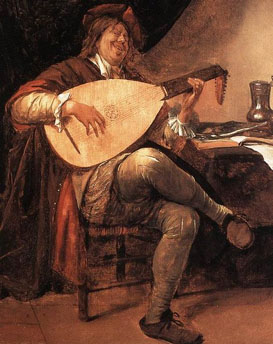| Jan Steen  AKA Jan Havicksz Steen AKA Jan Havicksz Steen
Born: 1626
Birthplace: Leiden, Netherlands
Died: 3-Feb-1679
Location of death: Leiden, Netherlands
Cause of death: unspecified
Remains: Buried, Pieterskerk, Leiden, Netherlands
Gender: Male
Race or Ethnicity: White
Occupation: Painter Nationality: Netherlands
Executive summary: Dutch subject painter Dutch subject-painter, born at Leiden in 1626, the son of a brewer of the place. He studied at Utrecht under Nicolas Knupfer, a German historical painter. Dr. Bode suggests, that, before entering Knupfer's studio, Jan Steen took drawing lessons from Jacob de Wet in Haarlem. He bases his theory on the internal evidence of such early pictures as the "Market at Leiden", the "Kermesse", "Calling for the Bride", and "St. John's Sermon." About the year 1644 Steen went to Haarlem, where he worked under Adrian van Ostade and under Jan Josephs van Goyen, whose daughter he married in 1649. In the previous year he had joined the painters guild of the city. In 1667 he is said to have been a brewer at Delft; in 1669 a small debt of ten florins owing to an apothecary led to the seizure and sale of his pictures, and in 1672 he received municipal authority to open a tavern. In 1673 he took a second wife, Maria van Egmont, the widow of a bookseller in Leiden. The accounts of his life, however, are very confusing and conflicting. Some biographers have asserted that he was a drunkard, and of dissolute life, but the number of his works -- Van Westrheene, in his Jan Steen, étude sur l'art en Holland, has catalogued nearly five hundred and Hofstede de Groot about double that number -- seems sufficient in itself to disprove the charge. His later pictures bear marks of haste and are less carefully finished than those of his earlier period. He died at Leiden in 1679.
The works of Jan Steen are distinguished by correctness of drawing, admirable freedom and spirit of touch, and clearness and transparency of coloring. But their true greatness is due to their intellectual qualities. In the wide range of his subjects, and their dramatic character, he surpasses all the Dutch figure painters, with the single exception of Rembrandt. His productions range from the stately interiors of grave and wealthy citizens to tavern scenes of jollity and debauch. He painted chemists in their laboratories, doctors at the bedside of their patients, card parties, marriage feasts, and the festivals of St. Nicholas and Twelfth Night -- even religious subjects, though in these he was least successful. His rendering of children is especially delightful. Dealing often with the coarser side of things, his work is full of humor; he depicts the comedy of human life in a spirit of very genial toleration, but now and again there appear keenly telling touches of satire which recall a pictorial moralist such as William Hogarth. Portraits from his brush are comparatively rare. The best known is the portrait of himself at the Rijksmuseum in Amsterdam.
The National Gallery contains three pictures by Jan Steen, of which the "Music Master" is the most important, and other excellent examples of his art in England are preserved in the Royal, the Bute, and the Northbrook collections, at Apsley House and Bridgewater House, and in the galleries of the Hague, Amsterdam, and the Hermitage of St. Petersburg. A remarkably fine example of his work, which appeared at the Royal Academy Winter Exhibition in 1907, is the "Grace Before Meat."
Do you know something we don't?
Submit a correction or make a comment about this profile
Copyright ©2019 Soylent Communications
|